Medieval
Castle Siege
Fast Play Rules for Students
< Home
>
By Matt
Fritz
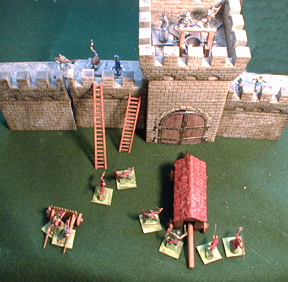 Version
2: I made some changes
to these rules. The original version can be found here.
I set up my castle on the corner of the table rather than in the
middle to make it easier for the students to reach the figures.
All figures were on individual bases, rather than two per base.
I added some new pieces to the castle, and some new siege equipment.
The melee rules were also modified slightly.
Version
2: I made some changes
to these rules. The original version can be found here.
I set up my castle on the corner of the table rather than in the
middle to make it easier for the students to reach the figures.
All figures were on individual bases, rather than two per base.
I added some new pieces to the castle, and some new siege equipment.
The melee rules were also modified slightly.
Historical Background: A well-built castle could control the
surrounding countryside and was very difficult to capture. If
you couldn't take it by trickery or treachery your best option
was to wait for disease and starvation to force the garrison to
surrender. If the castle was well provisioned, or the attackers
were in a hurry, then a direct assault might be attempted. The
tactics used were basically unchanged since ancient times. Moats
could be filled, a ram could bash in the gate, and catapults and
trebuchets could knock down the walls. Ladders or a siege tower
could also surmount the walls. Another popular (and dangerous)
tactic was to undermine the walls with a tunnel.
Battle 1: The attackers planned to send one siege tower against
the north and east walls. The catapults were set to fire on the
north wall, and the ballistae and bombard were deployed facing
the east wall. The battle began and both sides opened fire with
their archers and siege weapons. The defenders directed their
fire against the enemy archers, who found that their mantlets
were no protection against the heavy bolts fired from the ballistae.
The catapults destroyed a section of the north wall, and a force
of infantry headed for the opening. The catapults turned their
attention to the adjacent round tower. The defenders were forced
to abandon the tower and began preparing for a battle behind the
breached wall. The ram made it to the east wall and was promptly
drenched in boiling oil and set aflame. The attacking infantry
milled about in confusion, debating whether to retreat or try
a ladder assault, while the defending archers and ballistae tore
into them. Suddenly the bombard succeeded in breaching the east
wall and the relieved infantry headed for it. A ferocious melee
began in the breach as the defenders began feeding reserves into
the fight. Both towers reached the walls and dropped their bridges.
A seemingly endless wave of attackers stormed across, forcing
the defenders to send in the last of their reserves. Both sides
vowed to fight to the last man. For a while the issue was very
much in doubt, but in the end the defenders withstood the attack.
They were down to their last few foot soldiers before they could
claim victory.
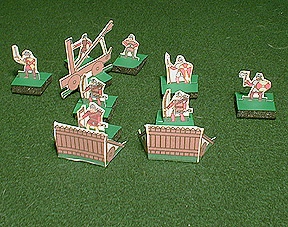 Battle 2: The attackers
sent both siege towers against the north wall, supported by the
bombard and a ballista. The ram was sent against the east gate,
with both catapults and a ballista also attacking the east side.
The attackers had trouble deciding where to target their catapults
and bombard. Rather than focusing on one section of the wall they
kept changing targets. The ram reached the east gate and fell
victim to the cauldron of boiling oil. At last the catapults breached
the east wall and all the attackers on the east side headed for
the gap. They were cut down by withering fire from the defenders.
A handful of survivors made it to the breach but they ran into
a wall of defenders and were wiped out. Both siege towers reached
the north wall and dropped their bridges. The defenders scrambled
to meet the attack. Their reserves were stretched to the limit,
and the archers had to join the melee. They were cut to pieces,
but held long enough for reinforcements to arrive. The battle
was very close until the attackers made a fatal mistake. They
tried to fool the defenders by shifting their attack from the
siege towers to a nearby breach in the wall. The maneuver backfired
when the attackers were hit with an avalanche of rocks from above
before they could even make it to the breach. The losses were
heavy enough to shift the advantage to the defenders, who won
a narrow victory.
Battle 2: The attackers
sent both siege towers against the north wall, supported by the
bombard and a ballista. The ram was sent against the east gate,
with both catapults and a ballista also attacking the east side.
The attackers had trouble deciding where to target their catapults
and bombard. Rather than focusing on one section of the wall they
kept changing targets. The ram reached the east gate and fell
victim to the cauldron of boiling oil. At last the catapults breached
the east wall and all the attackers on the east side headed for
the gap. They were cut down by withering fire from the defenders.
A handful of survivors made it to the breach but they ran into
a wall of defenders and were wiped out. Both siege towers reached
the north wall and dropped their bridges. The defenders scrambled
to meet the attack. Their reserves were stretched to the limit,
and the archers had to join the melee. They were cut to pieces,
but held long enough for reinforcements to arrive. The battle
was very close until the attackers made a fatal mistake. They
tried to fool the defenders by shifting their attack from the
siege towers to a nearby breach in the wall. The maneuver backfired
when the attackers were hit with an avalanche of rocks from above
before they could even make it to the breach. The losses were
heavy enough to shift the advantage to the defenders, who won
a narrow victory.
Rules
The Miniatures: The figures used were 1/72-scale plastics
mounted one per stand. The figures were mounted individually on
3/4" bases, leaders were marked by clipping the corners off
their bases. The figures were a mix from several sets. Most of
the figures were from Revell's Saxons and Normans, which are hard
to find now, but there are many, many other suitable figures on
the market. Here are some
paper soldiers you can print and use.
Siege Equipment: My siege engines were made by Zvezda.
Their Siege Machines kit #1 includes a catapult, ballista, and
three mantlets (I built two of these kits). Siege Machines kit
#2 comes with a covered ram, a mantlet, two ladders, and a cauldron.
I also used the ladders from their Medieval Fortress kit which
I purchased for a future project (it's a wooden fort and not suitable
for use as a stone castle). A cheap alternative is to simply draw
ladders onto strips of cardboard. Four scorpions from Hat #8035
Roman Catapults were small enough to fit in the towers, so they
were used for the defense. I also used Zvezda's siege towern and
built one of my own by covering an orange juice carton with craft
sticks - the thin rectangular kind (also called splints). A flap
cut near the top of the container served as a fighting bridge
after being covered and extended with craft sticks. The top of
the tower has a protected area for the archers. The wheels and
axles were made from popsicle sticks and 2-liter bottle caps.
The tower is servicable but a bit too wide. I also used a bombard
made by LW (they call it a mortar). Zvezda has produced a niece
trebuchet, but I didn't finish it in time. Here are some
paper siege weapons you can print and use.

The Castle: I decided to use Zvezda's Ancient Stone
Fortress for my castle. For about $40 you get four square towers,
two gatehouses, and a bunch of wall sections. They sell additional
wall sections and towers separately, and I bought two more sections
of wall, a round tower, and gatehouse with drawbridge. I'd avoid
the drawbridge, it's a pain to build and not worth the time and
effort. If this is too rich for your blood then it's not too hard
to scratch build a decent castle. Rob Dean, in Saga #67,
reports making a castle from heavy cardboard and oatmeal containers
for a class of fourth graders. During the battle the second gatehouse
was treated as tower. Many paper castle models are available for
free on the web. There's one on this web site right here: paper castle. There's a good
looking one made by By Rob Lazzaretti, Dennis Kauth, and Todd
Gamble available from Wizards
of the Coast. If you don't like that one try looking for a
paper castle at freepapertoys.com.
Here is a
paper castle you can print and build.
|
Attackers:
7 Leaders
105 finfantry
16 archers
1 covered ram
2 catapults
2 Ballistae
1 Bombard
10 mantlets
2 siege towers
fill moat in 5 places |
Defenders:
7 leaders
60 infantry
20 archers
5 ballista (in towers)
16 rock loads
1 cauldron boiling oil |
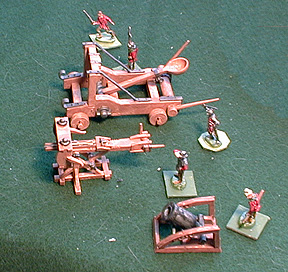 The
Board: A 5 X 5 foot table
was used with the castle located in the corner.
The
Board: A 5 X 5 foot table
was used with the castle located in the corner.
Deployment: The attackers may deploy anywhere at least
18" from the castle walls. The attackers may fill in the
moat in five places, these are the only places where they may
cross the moat. This can be represented by laying a piece of brown
felt across the moat. Each siege weapon must have one figure to
operate it. The ram needs two figures to move it, and the siege
towers each require four figures to move. Each mantlet can protect
two figures. The defenders should be on the walls and towers,
or inside the bailey as a reserve. The ballistae should be in
the towers, and cannot move during the battle. The cauldron of
boiling oil should be over the gate which the ram will attack.
The rock loads must be allocated to a wall section or tower (place
the rocks behind the castle piece). Rock loads can be dropped
only on enemies attacking the castle piece where the rocks were
allocated, or an adjacent castle piece.
Sequence of Play:
1. Attackers Move
2. Attackers Shoot
3. Melee
4. Defenders Move
5. Defenders Shoot
6. Melee
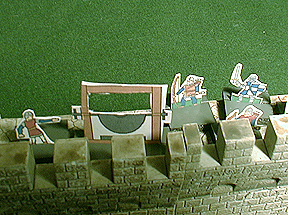 Movement: All infantry move 6". Each figure
may move on its own, there are no formations. It takes one move
to go from inside the castle onto the walls, or to go from the
walls up into a tower. Catapults, bombards, ballistae, the ram,
and the mantlets can be pushed 6" per turn. The ram takes
two figures to move, other equipment takes only one figure to
move. The ballistae on the castle towers cannot be moved. The
Siege tower can be pushed 3" per turn, and requires four
figures. A figure which begins its movement phase at the base
of a wall can use it's move to put up a ladder and climb. One
figure can climb if there is a defender above him (they will fight
a melee). Two figures can climb up a ladder if there is no defender.
Once the bridge of the siege tower has been lowered three figures
may cross onto the walls each turn if there are defenders in the
way (they will fight a melee). If there are no defenders then
six figures can cross per turn.
Movement: All infantry move 6". Each figure
may move on its own, there are no formations. It takes one move
to go from inside the castle onto the walls, or to go from the
walls up into a tower. Catapults, bombards, ballistae, the ram,
and the mantlets can be pushed 6" per turn. The ram takes
two figures to move, other equipment takes only one figure to
move. The ballistae on the castle towers cannot be moved. The
Siege tower can be pushed 3" per turn, and requires four
figures. A figure which begins its movement phase at the base
of a wall can use it's move to put up a ladder and climb. One
figure can climb if there is a defender above him (they will fight
a melee). Two figures can climb up a ladder if there is no defender.
Once the bridge of the siege tower has been lowered three figures
may cross onto the walls each turn if there are defenders in the
way (they will fight a melee). If there are no defenders then
six figures can cross per turn.
Shooting: Shooting is targeted at a wall section, tower,
or group of men. The person suffering casualties selects which
figures are removed. Archers and Ballistae have a range of 18".
Catapults and Bombards have a 24" range and will generally
fire from beyond range of the arrows and ballistae. Roll 1D6 for
each archer figure in range. The Archery Table shows the number
needed for a hit. Every hit removes one enemy figure. Units that
are engaged in melee may not fire, and may not be targeted. Ballistae
roll 1D6 and use the Ballistae and Dropped Rock Table. Each time
a catapult or bombard fires it inflicts 1D6 damage to the wall
or tower. Keep track of the accumulated damage until the wall
or tower collapses. One figure is required to operate each catapult,
bombard, and ballista. The battering ram inflicts 1D6 damage per
turn to the drawbridge, keep track of the damage until the drawbridge
is breached. Use common sense when considering line of sight.
Most of the attacker's fire will be directed up at the walls and
can be fired over the heads of their infantry. Catapults and bombards
should not fire at an area if attackers are in front of the target
and are inside the moat. Catapults cannot fire indirectly at targets
inside the walls. The defender's ballistae cannot fire at attackers
that have crossed the moat.
Dropping Rocks: Rock dropping is done during the defender's
shooting phase. The defenders have sixteen loads of rocks (represented
by pebbles) which can be dropped on attackers after they cross
the moat. The rock loads must be allocated to a wall section or
tower (place the rocks behind the castle piece). Rock loads can
be dropped only on enemies attacking the castle piece where the
rocks were allocated, or an adjacent castle piece.Roll 1D6 for
each load dropped and consult the Ballistae and Dropped Rock table
for the results. There are no reloads for dropped rocks.
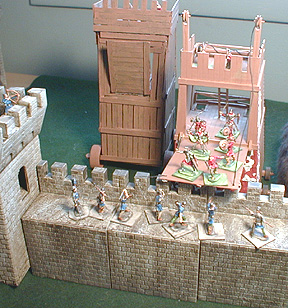 Boiling
Oil: A cauldron of boiling
oil is ready for use against the ram. This can be dumped once
per game. It can be used on the battering ram during the defender's
shooting phase - roll a 5 or 6 on 1D6 to destroy the ram. Alternatively
it can be dumped through murder holes when the attackers move
through the gatehouse. In this case resolve it during the attackers
movement phase. Roll 1D6 for each figure that moved through the
gatehouse during the turn. The figure is eliminated on a roll
of 3-6.
Boiling
Oil: A cauldron of boiling
oil is ready for use against the ram. This can be dumped once
per game. It can be used on the battering ram during the defender's
shooting phase - roll a 5 or 6 on 1D6 to destroy the ram. Alternatively
it can be dumped through murder holes when the attackers move
through the gatehouse. In this case resolve it during the attackers
movement phase. Roll 1D6 for each figure that moved through the
gatehouse during the turn. The figure is eliminated on a roll
of 3-6.
Melee: Enemy units in contact with one another will fight
a melee. Each fight is handled as a one on one battle and resolved
separately. Although this slows the game down it adds to the suspense.
Each player rolls 1D6 simultaneously and adds any bonuses that
apply - check the Melee Table. The player with the lower modified
roll is eliminated, the castle defenders win all ties. If two
large groups meet in melee you can keep rolling off the battles
as a series on one on one fights until all the figures from one
side have been eliminated.
Breaching the Walls and Drawbridge:
Wall sections can withstand
16 points of damage, towers can take 25 points of damage, and
the drawbridge can take 13 points of damage before breaking. When
a wall section or tower collapses any figures that were on it
are eliminated. Remove the wall section or tower and replace it
with a small pile of pebbles to represent the rubble. Attackers
can move across the breach on future turns. When the drawbridge
is broken the gates should be opened and the attackers can move
through on the next turn.
Siege Tower: The siege tower can shelter up to 20
figures inside. These figures are immune to enemy fire. The figures
can be placed inside the tower model, if convenient, or directly
behind the tower. If the siege tower has a protected top then
any figures on top get the same protection as if they were behind
a mantlet. Once the siege tower gets within a few inches of the
walls it can try to lower the fighting bridge. If the defenders
have at least one stand on the walls in front of the tower they
can attempt to prevent this (poles would be used to keep the bridge
up). The defender rolls 1D6 and a roll of 5 or 6 prevents the
bridge from dropping, any other number and the bridge is lowered
and can be used next turn. The defender must roll each turn to
prevent the bridge from lowering but once lowered it cannot be
forced closed again. Once the bridge has been lowered three figures
can immediately cross and fight the defenders, or six figures
can cross if there are no defenders in the way. Each movement
phase three (or six) more figures can cross. If three figures
cross the bridge and fight a melee against the attackers, they
can continue to fight one on one battles until they are all killed,
or the defenders are eliminated.
Mines, Flaming Arrows, and
Other Cool Stuff: I followed
the "Keep it Simple" philosophy and left out rules for
some actions that players might want to try. If you want to include
these things just make up your own rules, or check out the Tactica
Medieval Rulebook for some good ideas.
Victory Conditions: The attackers must take decisive control
of the castle by the end of the game (about 90 minutes).
< Home
>
Resources: A search of the Internet, and Magweb,
turned up some useful resources for wargaming a medieval castle
siege.
- Tactica Medieval Rulebook, by Arty Conliffe and Ed Regendahl,
the siege supplement has a nice rule mechanic for mining
- "Castle Assault Project,"
by Rob Dean, Saga # 67, designed for fourth graders
- "Castle Attack," by
Gary Comarado, Saga # 38
- "Thoughts on Gaming Feudal
Sieges," by Gary Comarado, Saga # 67
- "The Siege of Castle Sikesmore,"
by Chip Coffer and Dwight Jones, The Courier # 79
- "Art of the Siege,"
by Bob Duncan, Tornado Alert! # 23
Melee Modifiers
|
Unit |
Modifier |
|
Opponent climbed ladder this turn |
+1 |
|
Leader |
+1 |
|
Archer |
-1 |
|
Archery Table
|
Target |
Hit # |
|
Protected by walls or mantlets |
6 |
|
Unprotected |
5-6 |
|
Ballistae and Dropped Rocks
|
1 |
miss |
|
2-5 |
1 stand eliminated |
|
6 |
2 stands eliminated |
|
 Version
2: I made some changes
to these rules. The original version can be found here.
I set up my castle on the corner of the table rather than in the
middle to make it easier for the students to reach the figures.
All figures were on individual bases, rather than two per base.
I added some new pieces to the castle, and some new siege equipment.
The melee rules were also modified slightly.
Version
2: I made some changes
to these rules. The original version can be found here.
I set up my castle on the corner of the table rather than in the
middle to make it easier for the students to reach the figures.
All figures were on individual bases, rather than two per base.
I added some new pieces to the castle, and some new siege equipment.
The melee rules were also modified slightly. Battle 2: The attackers
sent both siege towers against the north wall, supported by the
bombard and a ballista. The ram was sent against the east gate,
with both catapults and a ballista also attacking the east side.
The attackers had trouble deciding where to target their catapults
and bombard. Rather than focusing on one section of the wall they
kept changing targets. The ram reached the east gate and fell
victim to the cauldron of boiling oil. At last the catapults breached
the east wall and all the attackers on the east side headed for
the gap. They were cut down by withering fire from the defenders.
A handful of survivors made it to the breach but they ran into
a wall of defenders and were wiped out. Both siege towers reached
the north wall and dropped their bridges. The defenders scrambled
to meet the attack. Their reserves were stretched to the limit,
and the archers had to join the melee. They were cut to pieces,
but held long enough for reinforcements to arrive. The battle
was very close until the attackers made a fatal mistake. They
tried to fool the defenders by shifting their attack from the
siege towers to a nearby breach in the wall. The maneuver backfired
when the attackers were hit with an avalanche of rocks from above
before they could even make it to the breach. The losses were
heavy enough to shift the advantage to the defenders, who won
a narrow victory.
Battle 2: The attackers
sent both siege towers against the north wall, supported by the
bombard and a ballista. The ram was sent against the east gate,
with both catapults and a ballista also attacking the east side.
The attackers had trouble deciding where to target their catapults
and bombard. Rather than focusing on one section of the wall they
kept changing targets. The ram reached the east gate and fell
victim to the cauldron of boiling oil. At last the catapults breached
the east wall and all the attackers on the east side headed for
the gap. They were cut down by withering fire from the defenders.
A handful of survivors made it to the breach but they ran into
a wall of defenders and were wiped out. Both siege towers reached
the north wall and dropped their bridges. The defenders scrambled
to meet the attack. Their reserves were stretched to the limit,
and the archers had to join the melee. They were cut to pieces,
but held long enough for reinforcements to arrive. The battle
was very close until the attackers made a fatal mistake. They
tried to fool the defenders by shifting their attack from the
siege towers to a nearby breach in the wall. The maneuver backfired
when the attackers were hit with an avalanche of rocks from above
before they could even make it to the breach. The losses were
heavy enough to shift the advantage to the defenders, who won
a narrow victory.
 The
Board: A 5 X 5 foot table
was used with the castle located in the corner.
The
Board: A 5 X 5 foot table
was used with the castle located in the corner. Movement: All infantry move 6". Each figure
may move on its own, there are no formations. It takes one move
to go from inside the castle onto the walls, or to go from the
walls up into a tower. Catapults, bombards, ballistae, the ram,
and the mantlets can be pushed 6" per turn. The ram takes
two figures to move, other equipment takes only one figure to
move. The ballistae on the castle towers cannot be moved. The
Siege tower can be pushed 3" per turn, and requires four
figures. A figure which begins its movement phase at the base
of a wall can use it's move to put up a ladder and climb. One
figure can climb if there is a defender above him (they will fight
a melee). Two figures can climb up a ladder if there is no defender.
Once the bridge of the siege tower has been lowered three figures
may cross onto the walls each turn if there are defenders in the
way (they will fight a melee). If there are no defenders then
six figures can cross per turn.
Movement: All infantry move 6". Each figure
may move on its own, there are no formations. It takes one move
to go from inside the castle onto the walls, or to go from the
walls up into a tower. Catapults, bombards, ballistae, the ram,
and the mantlets can be pushed 6" per turn. The ram takes
two figures to move, other equipment takes only one figure to
move. The ballistae on the castle towers cannot be moved. The
Siege tower can be pushed 3" per turn, and requires four
figures. A figure which begins its movement phase at the base
of a wall can use it's move to put up a ladder and climb. One
figure can climb if there is a defender above him (they will fight
a melee). Two figures can climb up a ladder if there is no defender.
Once the bridge of the siege tower has been lowered three figures
may cross onto the walls each turn if there are defenders in the
way (they will fight a melee). If there are no defenders then
six figures can cross per turn. Boiling
Oil: A cauldron of boiling
oil is ready for use against the ram. This can be dumped once
per game. It can be used on the battering ram during the defender's
shooting phase - roll a 5 or 6 on 1D6 to destroy the ram. Alternatively
it can be dumped through murder holes when the attackers move
through the gatehouse. In this case resolve it during the attackers
movement phase. Roll 1D6 for each figure that moved through the
gatehouse during the turn. The figure is eliminated on a roll
of 3-6.
Boiling
Oil: A cauldron of boiling
oil is ready for use against the ram. This can be dumped once
per game. It can be used on the battering ram during the defender's
shooting phase - roll a 5 or 6 on 1D6 to destroy the ram. Alternatively
it can be dumped through murder holes when the attackers move
through the gatehouse. In this case resolve it during the attackers
movement phase. Roll 1D6 for each figure that moved through the
gatehouse during the turn. The figure is eliminated on a roll
of 3-6.